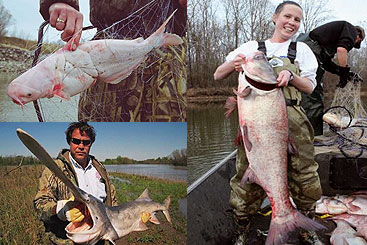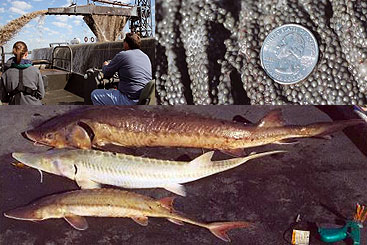Catfish, carp and caviar: fisheries of the Danube and Mississippi rivers
ICPDR Danube Watch: The ICPDR in the spotlight

Catfish, carp and caviar: fisheries of the Danube and Mississippi rivers
Some of the most famous rivers around the world face the same challenges in protecting fish populations. Sustainable solutions can be found through sharing experiences with other large river basins.

Rare leucistic blue catfish, silver carp and the paddlefish represent various challenges the Mississippi River Basin currently faces regarding fishery sustainability – challenges also faced in the Danube River Basin.
The Danube River and Mississippi River each consist of a long channel (2780 and 3730 km), flowing through a large basin (801,463 and 2,981,076 km²) of diverse floodplain habitats, and are inhabited by rich faunas of freshwater fishes – each home to more than 90 species.
Both rivers are also important public and commercial resources for the countries and states that border them, and are utilised in many ways. Upper reaches of both rivers have a system of structures (15 locks in the Upper Danube, 26 lock-and-dams in the Upper Mississippi) to facilitate navigation but which can restrict long-range migrations of fish. Levees border both rivers to provide flood control but limit seasonal movements of fish onto the floodplains.
It is no surprise then that fisheries of both rivers face some of the same challenges to their sustainability. What may be surprising to some, though, is that the fisheries are themselves similar in the two rivers.
Catfishes. The Danube River is inhabited by a single species of catfish, the wels catfish (Silurus glanis) which attains titanic proportions – up to 500 cm and 100 kg – and is highly prized by epicures and sportsmen.
The Mississippi River, by contrast, is home to ten species of lesser size, but these too are highly sought by fish aficionados. Madtoms (Noturus spp) are tiny at smaller than 10 cm and less than 0.1 kg and characteristic of tributary streams, but at least four species occur in or adjacent to the main channel of the river. They are venomous and can inflict a painful, burning sting with their spines, but are sometimes collected for display in home aquaria. Bullhead catfishes (Ameiurus spp.) are medium-sized – between 47–66 cm and 1.9–3.6 kg – and typical of backwaters and wetlands where they are occasionally caught by anglers. Blue catfish (Ictalurus furcatus), channel catfish (I. punctatus), and flathead catfish (Pylodictus olivarus) are large – between 132–165 cm and 26.3–68.0 kg – and are abundant in the main channel of the river where they support commercial and recreational fisheries.
Like their European counterparts, US fishermen and biologists use a variety of techniques to catch these larger species including hoop-nets, gill-nets and lines of baited hooks. The most unusual technique, ‘noodling’, is to simply reach into a cavity or specially placed box and grab the catfish using only bare hands. The European technique of ‘clonking’ is not widely employed, but the accepted practice of releasing larger, and less palatable, fish to maintain spawning populations is also common among US fishermen. Of the three larger catfish species, only one, the channel catfish, is intensively and extensively cultivated for food.
Carps disrupting natural balances. In the 1960s, large Asian carps were introduced as aquaculture species in the Danube Basin. In the 1970s, the same species were introduced for biological control of noxious plants in the Mississippi Basin. In both cases, they escaped into the main channels of the river, established breeding populations and became dominant components of the fauna.
Grass carp (Ctenopharyngodon idella) feed on aquatic macrophytes, bighead carp (Hypophthalmichthys nobilis) and silver carp (H. molitrix) on plankton. Individually and collectively they disrupt natural aquatic food webs by removing plants needed as cover or food by native fishes. Silver carp infest floodplain wetlands in large numbers, consume enormous quantities of plankton and deplete food sources for native planktivores. They selectively digest certain species of plankton, producing large amounts of faeces rich with living algae of low food value for other species and which can degrade water quality.
Asian carp also pose an economic threat by damaging nets of commercial fishermen and by reducing catch of other more marketable species. Silver carp pose safety threats to people on the river. At the approach of a motorboat, they often leap high into the air where they may land in boats, and on passengers, frequently knocking people over and sometimes injuring them.
Controlling populations. Eradication of Asian carp is unlikely, but populations can be controlled and economic impacts mitigated. Gated culverts can be used to block lateral movements of carp from river channels to floodplain wetlands. An electrical barrier constructed in a canal near Chicago has prevented carp from moving upstream from the Mississippi River into the Great Lakes for more than six years. Economic impacts of the carp can be partly offset by developing outlets for the meat. In the Middle Mississippi River, in Missouri and Illinois, fish are exported to Asia; in the lower Mississippi River, in Arkansas, studies are being conducted to package and promote carp meat locally as an alternative to other canned fish, like tuna and salmon.

Paddlefish are infrequently encountered in many river studies, but their presence is critical for identifying and protecting gravebed spawning grounds of all caviar-producing species. Lake sturgeon, pallid sturgeon and shovelnose sturgeon from the Middle Mississippi River.
Caviar, and sturgeon at risk. Salted roe is a highpriced delicacy in Europe and in the United States. In the Danube River, caviar was provided historically by five large sturgeon species that reside in the Black Sea and spawn up river, and by a sixth smaller species that occurs only in the river but is widely distributed. With the exception of the smallest species, all Danube sturgeon are endangered.
In the Mississippi River, there are four species of sturgeon. The Gulf sturgeon (Acipenser oxyrinchus desotoi) is large, resides in the Gulf of Mexico and spawns in rivers, but rarely goes far into the Mississippi River due to a natural lack of spawning habitat. The lake sturgeon (A. fulvescens) is also large but occurs only in the middle and upper river. The pallid sturgeon (Scaphirhynchus albus) and the shovelnose sturgeon (S. platorynchus) are smaller. Both species occur throughout the Middle and Lower Mississippi River and throughout the Missouri River, principal tributary to the Mississippi. The shovelnose also occurs in the Upper Mississippi River and in smaller tributaries of the Mississippi River.
Of the Mississippi River sturgeon, only the shovelnose sturgeon is not considered imperilled and is harvested for its caviar and meat. The pallid sturgeon is listed federally as ‘endangered’, Gulf sturgeon federally as ‘threatened’, and lake sturgeon by most states as imperilled – regionally endangered, threatened, special concern or rare.
There is a fifth species of caviar fish in the Mississippi – the paddlefish (Polyodon spathula). This fish has many anatomical features in common with sturgeon, and is related to the group, but has a different lifestyle: freeswimming in the open water instead of hovering close to the river bottom. It also has a prominent, blade-like paddle, with which it locates planktonic animals on which it feeds. Since its discovery in the 16th century, virtually nothing was known of the reproduction of this fish, and small specimens became a ‘holy grail’ for naturalists. Discovered in the 1930s, paddlefish larvae and tiny juveniles are still infrequently encountered in many river studies, but their presence is critical for identifying and protecting gravel-bed spawning grounds of all caviar-producing species. In 2006, paddlefish were collected in the Danube River; they are believed to have been introduced from an aquaculture facility.
Finding protective measures. Danube caviar fishes are rare or locally extinct from upper reaches of the system, and populations in the lower reaches are threatened by over exploitation. A similar situation occurs in the Mississippi River. Pallid sturgeon in the upper Missouri River, isolated by dams, have not spawned successfully in decades. The aging populations there are supplemented with young fish produced in hatcheries. In the Middle Mississippi River, where fishing is permitted for the look-alike shovelnose sturgeon, populations of pallid sturgeon experience high rates of mortality, from poaching and from accidental bycatch. Only in the lower Mississippi River, where state governments have voluntarily banned any fishing for sturgeon, is sturgeon mortality low and abundance high.
In addition to prohibitions on fishing, other protective measures for Mississippi caviar-producing species include size and season-based fishing regulations (paddlefish and lake sturgeon), restrictions on dredging during spawning and rearing seasons, guidelines for water releases and water withdrawals from rivers, and restoration of fish passage (all species). It is also worth noting that some entrepreneurs are developing alternative sources of caviar by exploiting smaller, faster-maturing, easy-to-cultivate species, like the bowfin (Amia calva).
Cooperation for conservation. The Danube River and the Mississippi River are the principal arteries for two continents; they provide water supply, flood control, navigation and commerce for ten nations and for ten states respectively. As such, each river presents substantial challenges to its own sustainable fisheries and their management.
In the Mississippi River, these challenges are met by the US Army Corps of Engineers working with other federal agencies (e.g. the United States Fish and Wildlife Service) and inter-jurisdictional groups (e.g. Mississippi Interstate Cooperative Resource Association, Lower Mississippi River Conservation Committee).
Together, these efforts enable comprehensive environmental assessments and coordinated management actions. As examples, comprehensive assessments of pallid sturgeon are beginning to establish viability of the species and to evaluate risks and benefits of proposed management practices. Effects of dredging and navigation are evaluated empirically through large-scale field experiments. Habitat restoration measures, for sturgeon and other species, are prioritised using decision-support models and geomorphological data. This approach guarantees that civil works projects cause minimal environmental and economic impact, and that management actions provide maximum benefits for minimum cost.





